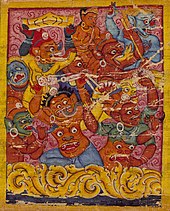
Back Mara (demoon) Afrikaans মার Bengali/Bangla Mára Czech Mara (buddhisme) Danish Mara (Buddhismus) German Marao Esperanto Mara (budismo) Spanish Māra (budism) Estonian ماره Persian Māra French




Mara,[note 1] in Buddhism, is a malignant celestial king who tried to stop Prince Siddhartha from achieving Enlightenment by trying to seduce him with his celestial Army and the vision of beautiful women who, in various legends, are often said to be Mara's daughters.[1]
In Buddhist cosmology, Mara is associated with death, rebirth and desire.[2] Nyanaponika Thera has described Mara as "the personification of the forces antagonistic to enlightenment."[3]
Cite error: There are <ref group=note> tags on this page, but the references will not show without a {{reflist|group=note}} template (see the help page).
- ^ See, for instance, SN 4.25, entitled, "Māra's Daughters" (Bodhi, 2000, pp. 217–20), as well as Sn 835 (Saddhatissa, 1998, page 98). In each of these texts, Mara's daughters (Māradhītā) are personified by sensual Craving (taṇhā), Aversion (arati), and Passion (rāga).
- ^ Trainor, Kevin (2004). Buddhism: The Illustrated Guide. Oxford University Press. p. 34. ISBN 9780195173987.
- ^ Thera, Nyanaponika (2008). The Roots of Good and Evil: Buddhist Texts translated from the Pali with Comments and Introduction. Buddhist Publication Society. p. 22. ISBN 9789552403163.
© MMXXIII Rich X Search. We shall prevail. All rights reserved. Rich X Search